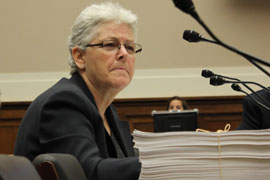Cronkite News has moved to a new home at cronkitenews.azpbs.org. Use this site to search archives from 2011 to May 2015. You can search the new site for current stories.
Navajo official: New EPA emissions rule could cost thousands of jobs
WASHINGTON – Power plants on Navajo Nation land need more time to meet new emissions standards or they could be forced to close, throwing thousands of Navajo out of work and costing the tribe millions, an official said Wednesday.
Navajo Attorney General Harrison Tsosie told a House committee that while the tribe supports clean-air standards, the Environmental Protection Agency’s proposed Utility Maximum Achievable Control Technology rule – intended to lower mercury emissions from power plants – is too harsh.
“Indian nations are often cited as being pockets of poverty … and the one common denominator is pervasive federal control,” Tsosie told members of a House Energy and Commerce subcommittee. “The United States EPA MACT rule is no exception and adds yet another regulatory burden tribes are left to contend with.”
Without some leeway, he said, the rules could force the closure of power plants and coal mines that provide the Navajo Nation a third of its operational budget.
“Revenue and job losses of that magnitude would be cataclysmic for the Navajo Nation and its people, and would certainly impugn the very solvency of the Navajo Nation government,” his written testimony said.
The 1,100-page EPA rule, which is set to take effect in April, gives current generating stations four years to comply, but Tsosie said power plants in and around the Navajo Nation would need 20 to 25 years.
“The difficulty is what do we do with the old facility when we haven’t built the new facilities yet?” he said. “So there’s a transition period that we need.”
But an EPA official testified that “the country can achieve these standards.”
“EPA’s final … standards are data-driven, will reduce emissions of toxic air pollutants from power plants, and will lead to healthier communities and a safer environment,” said Gina McCarthy, the EPA’s assistant administrator for air and radiation.
McCarthy defended the new rules during almost two hours of testimony before a sometimes-hostile committee.
“Together we do have the tools to address any challenges that may arise in the implementation of the Mercury and Air Toxics Standards,” she said.
McCarthy said the EPA is currently aware of only one generating station in the country that already meets the new standards. But she said also the new rule would lead to the creation of 46,000 temporary jobs as plants upgrade to meet new standards, and 8,000 permanent jobs thereafter.
Other supporters of the regulations said it is past time to lower mercury emissions from power plants.
The Rev. Mitchell Hescox, the president and chief executive of Evangelical Environmental Network, said in his written testimony 50 percent of domestic mercury sources are coal-fired utilities. Hescox said his group has waited for the country to clean up mercury from the burning of fossil fuels for decades.
“It is well past time to act – no more delays or special treatment of one industry over another,” he said in his written testimony.
But Tsosie said the Navajo are not ready to support the new rule because the EPA has not yet provided data showing that mercury-emission levels are dangerous.
“Obviously, if we found that mercury was going to have a devastating impact on the Navajo Nation we would take appropriate measures to control or shut down the plant,” he said. “But right now that data doesn’t exist.”
He pointed to one study that said if the new rules forced the closing of the Navajo Generating Station, it could lower Arizona’s gross state product by a total of $20.5 billion between now and 2044. A recent EPA report cited the Navajo Generating Station as 13th in the nation for greenhouse-gas emissions in 2010.
While it is the nation’s job to protect its people and their health, Tsosie said it is also the nation’s job to help them create revenue.
“It’s a balancing act for us,” he said.








